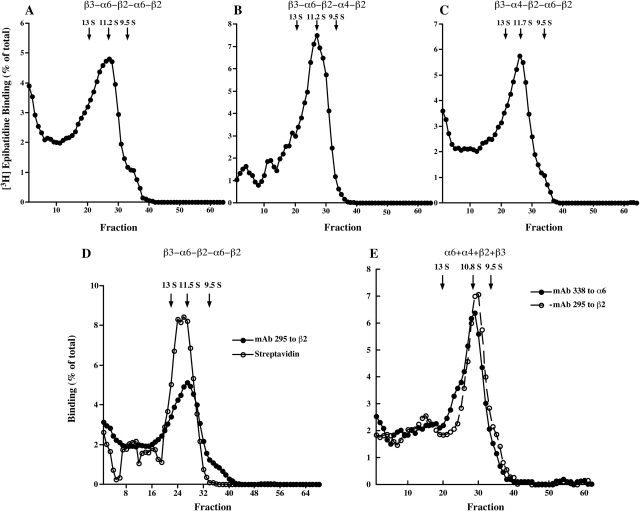Fig. 10.
Concatameric pentamers sediment on sucrose velocity gradients as components of the expected size, intermediate between that of T. californica AChR monomers (9.5 S) and dimers (13 S). Fractions are numbered from the bottom of the gradients up. α6β2β3* AChRs in each gradient fraction were isolated using microwells coated with mAb 295 to β2 subunits, then labeled with [3H]epibatidine. α1β1γδ T. californica AChRs were used as internal standards on each gradient. They were isolated using microwells coated with mAb 210 to α1 subunits, then labeled with 125I-α-bungarotoxin. Only the locations of the peaks corresponding to T. californica monomers and dimers are shown. A, β3-α6-β2-α6-β2 concatamers assemble primarily into mature AChRs somewhat larger than T. californica AChR monomers, although a few form larger aggregates. B, β3-α6-β2-α4-β2 concatamers assemble almost exclusively into mature AChRs, with few larger aggregates being formed. C, β3-α4-β2-α6-β2 concatamers assemble primarily into mature AChRs, although a small amount form larger aggregates. Subunit order or composition do not seem to have large effects on efficiency of assembly of pentameric concatamers into mature AChRs. D, oocytes expressing β3-α6-β2-α6-β2 were surface labeled with biotin. After extraction with Triton X-100 and sedimentation, aliquots of each fraction were isolated on microwells coated with either mAb 295 to bind β2 or streptavidin to bind biotinylated AChR, and then labeled with [3H]epibatidine. This shows that surface AChRs have the same size as intracellular AChRs. E, a human embryonic kidney cell line transfected with α6, α4, β2, and β3 subunits was extracted with Triton X-100, sedimented on a sucrose gradient, aliquots of each fraction were isolated on microwells coated with either mAb 295 to β2 subunits or mAb 338 to α6 subunits, finally, AChRs were labeled with [3H]epibatidine. This shows that both α6β2* and α4β2* AChRs formed from free subunits sediment at nearly the size of the concatamers. The concatamers sediment slightly more rapidly, probably because of the mass of the linkers.

